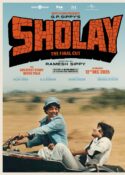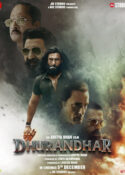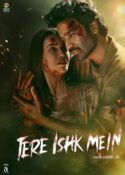 “Two Countries. Two Cultures. One Chance at Love” is the tag line for the new film The Other End of the Line that opens this Friday. It is not only a cross-cultural romance, but also a collaboration of Bollywood and Hollywood production studios (MGM, Hyde Park Entertainment and Adlabs!) and boasts a cast of American and Indian actors and actresses including Jesse Metcalfe, Shriya Saran, and Anupam Kher. According to director James Dodson, the film is shamelessly romantic. I got the chance to speak with this enthusiastic director as he talked about working in India, working with the fabulous cast, and how pleased he is with the romance in final print!
“Two Countries. Two Cultures. One Chance at Love” is the tag line for the new film The Other End of the Line that opens this Friday. It is not only a cross-cultural romance, but also a collaboration of Bollywood and Hollywood production studios (MGM, Hyde Park Entertainment and Adlabs!) and boasts a cast of American and Indian actors and actresses including Jesse Metcalfe, Shriya Saran, and Anupam Kher. According to director James Dodson, the film is shamelessly romantic. I got the chance to speak with this enthusiastic director as he talked about working in India, working with the fabulous cast, and how pleased he is with the romance in final print!
What made you decide to direct this film?
It was just so refreshing. You know I did a short film, a very funny short film, that got me a lot of scripts that were funny or supposedly funny, and romantic comedies are sort of bread and butter projects in Hollywood so you read a lot of them. And Ashok (Amritraj) and I had been talking about working together for about 6 months on a couple of different projects and then he sent me this script and he said, “Is there any chance you could go to Mumbai on Monday?”. So I read the script over the weekend and met with him, and I just found it to be really ready to shoot; all the development had happened – they worked two years on it. I just found it very charming and I liked the characters, I liked the girl. I liked the boy. I liked her family. I liked learning about her culture and her world. So absolutely, it was just on the fundamentals of the good screenplay that I accepted the job. The idea of going to India sounded fun but really it was just a good script, you know. Every once in a while you read a script and you think this one deserves to be shot. That is definitely how I felt with this one. Tracey Jackson did a great job with the writing.
 What was the casting process like? Particularly, why did you choose Shriya for the lead role?
What was the casting process like? Particularly, why did you choose Shriya for the lead role?
Well, we looked at every young woman in Mumbai who was working. We had an embarrassment of riches. The caliber of actresses that met with us – I think that speaks to Ashok’s reputation over there. So we had a lot of choices, but Shriya just came off as being so fresh and unique and not like anyone else I had met – not just in India. She is just the genuine article, you know. Everything she portrays on screen of being gracious and nice and polite and educated and intelligent and interested in you, and actually listens to you when you talk – these are qualities that Shriya actually has, so she is just playing herself up there, and she just blew us all away. Not to mention she is just dazzlingly pretty and beautiful. I really kept thinking about Audrey Hepburn as I would listen to her. She has got a very distinct voice – it has got an interesting tambour to it and it has a little “crinkly-ness” to it that Audrey Hepburn used to do. There are certain words she would just sort of ‘crinkle up’ (I really wish you could hear Mr. Dodson say that! – SY) in her throat you know, and I really think that Shriya is the Indian Audrey Hepburn.
What can you tell us about working with Jesse Metcalfe?
Man, the guy is such a pro. He had been part of the project before I got involved, and when he showed up in India his script was covered, every page was covered, with ink. He had prepared and asked questions and pre-visualized how he would look, what he would wear. He has his lines down. He is just a complete professional. He takes his job very seriously.
What about working with Anupam Kher?
Very similar kind of thing. Total professional: was constantly teaching me things. I took an instant liking to him. I didn’t know his work. I had seen Bend it Like Beckham, because you know I am a white guy living in LA (laughs). But I have subsequently seen many other of his films and came to realize that he is a huge star in his country – hugely loved – you know he is sort of like Daddy for all of India. And he runs an actors studio. So I met him as a teacher. My assistant over there was an acting student who had taken classes from Mr. Kher’s school. So I met with Anupam – first we kind of had to do the dance to get him to say yes, and then I went back to the “well” to ask him if he would kind of give me lessons in Indian life. How would a father talk to his daughter? How would a father behave towards his wife? Toward his aunts? The whole family intradynamics. How would Priya behave in this call center? How would she dress? So I really, really relied on his expertise and his knowledge and his generosity. So really, he is one of these guys who has really devoted himself to being a service to others. It’s amazing!
How was it shooting in India?
Completely not what I expected. Every filmmaker in Hollywood is ashamed to be told that Bollywood makes twice as many movies as Hollywood. So when I got there I expected sort of the Hollywood system on steroids, and I discovered they make movies way different then we do! They don’t prep a whole schedule. They shoot in shifts. So they will shoot a dance number, then shut down for three weeks, then shoot a series of scenes and then shut down. Maybe do some editing. Re-gather the team 3 months later, find the wardrobe, shoot some more and it is an entirely different system. They build sets; they don’t shoot as many practical locations, primarily because Mumbai, not unlike Hollywood, is just kind of shot out. All the key locations have had film crews there and the crews have destroyed their hardwood floors so no more shooting is allowed there. So I was shocked to discover how challenging it was going to be to make this movie. Plus, we had sort of arrogantly decided we were going to shoot all these New York scenes and San Francisco scenes in Mumbai. So we were covering those two cities in Mumbai. I mean, we pulled it off. You would never know it. We used green screen a lot. So pretty much anytime you see these two lovers sitting somewhere, and we are saying it is New York, it is probably Mumbai. Unless there is a cable car or the Golden Gate Bridge in the shot, it is probably in Mumbai.
 Any memorable moments from the shoot?
Any memorable moments from the shoot?
Oh man, everyday was a memory, because, you know, when you go somewhere new, you are gone for three days and you feel you have been gone for a lifetime. That was what it was like in Mumbai. I mean everyday, just learning the words and the culture and the tastes and the flavors, how to get around. As a filmmaker, you sort of need to also put on your producer hat, too, and think, well, this is a really great location but it is 2 hours from the hotel, which means that is 4 of our 12 shoot hours, so we have 8 hours to shoot this five page scene, maybe we should take a location nearer the other place so we can do a company move and all that stuff. So you have to learn the city and the geography of the city so you can make these decisions with your producer. It was just a constant learning experience. If I had to pick one memorable moment… one morning, like two in the morning, I woke up to fireworks, and I looked outside at this beach, Juhu Beach, where we were staying. There were ten thousand Indians in gorgeous clothing celebrating something to do with the elephant god, Ganesh. They were taking the Ganeshes and putting them out in the ocean and floating them away. It was amazing. Just this huge celebration. And I was embarrassed, because I felt like the workaholic American sort of bringing my “workaholism” to this culture that really loves to celebrate life – loves good food and good friends and good family. I would say things like, I haven’t talked to my sister in 3 months, and they are like, are you serious? How can you go 3 months without talking to your sister? They have a real love of family and friends, and we Americans tend to get so ambitious, and so single-minded on our work in our career track, that we really kind of let go of that socializing time.
What is your favourite scene in the film?
Well, there are some pretty cool visual effects that I was really happy that we pulled off. There is this cool shot where we shot the hotel in Mumbai and then we rotoscoped in a cable car, and the San Francisco Bay is the right hand of the frame, and the hotel in Mumbai. There are 130 visual effects in our movie, and this is a movie that you would never guess that it has visual effects, because they are all very subtle and nuanced. We are not supposed to dazzle you with them, we are just trying to pull off some cinematic slight of hand to create New York and San Francisco. Those were fun because they were kind of scary and risky because if we didn’t pull them off well, they would take you out of the movie, and they did come off, I think. There is a really romantic walk on the pier that is a great scene. Shriya was freezing – we shot it at like eleven at night in San Francisco in December. You know it is that wet San Francisco cold that just goes right to your bones. She was shivering and she brought all of this misery into the scene and it made for this really complex scene where she is looking at him. She says, “I just want to do things that make people happy,” and Jesse Metcalfe looks at her and says, “Why don’t you do something that makes you happy.” It is a really sweet, precious moment, and they are so vulnerable, and the set was so pretty. It was just kind of one of those moments of “this is why I went to film school.” This is shamelessly romantic filmmaking and that is what we were going for.
 Have you ever seen a Bollywood film before?
Have you ever seen a Bollywood film before?
I certainly have now because I watched many from a casting perspective as we were over there, but I had maybe seen one or two but it really wasn’t on my radar until I got there and saw. Which was so great, it was so great to see Bollywood’s “clichés”, because it made me aware of how many clichés we use in Hollywood filmmaking: there are basically seven plot lines and we just keep regurgitating them over and over and over again. But to see them in another culture made me realize just how guilty of that we are ourselves, but we have a blind spot to it we can’t see it. So it was interesting. If we were shamelessly romantic, then they were shamelessly enthusiastic about life and enthusiastic about song and love and sentiment. I loved it!
Would you like to make a Bollywood movie?
Oh, I’d LOVE to – are you kidding me? Just to be shameless in your set design and your costumes and your colors. Absolutely! It would be a hoot.
How was it working with both Bollywood and Hollywood production companies?
You know, when it comes to making movies, these guys are utter professionals, completely world-class filmmakers. The crew was freaking great; they are really fast and really accomplished. You know filmmakers, we are sort of like gypsies and our equipment is kind of universal. Sure, they had their tricks they only have in India. It was really great. We lucked out – we got a really strong crew; we were lucky because it was a really busy time. Danny Boyle was there making Slumdog Millionaire and they were prepping Shantaram , which is a big book that Johnny Depp was going to make, and then that movie shut down, but they hogged a lot of crew while we were shooting and took them off the market. So we were competing with other filmmakers and we really did well. We had a great AD department a great art department, a great lighting and camera department. It was really good.
How do you feel the film turned out?
I am amazed, you know, because I was just telling a friend here that I feel like I got off the plane in Mumbai and I tripped, and I was tripping forward for 100 days trying to catch my balance, and I never caught it until I got back on the plane. It was so chaotic and it was so ambitious and we were just shooting so fast, and at times it felt so reckless, that when I came back in January and started putting the movie together I was SHOCKED to discover we had shot entire scenes, it was all there. So, I am just so pleased that our original ambition was to shoot this elegant wide screen 2:3:5 aspect ratio classic Hollywood American-style romantic comedy in this chaos, and we were able to pull it off. It was really nothing short of a miracle that it happened. I mean just outside the frame line there are 10,000 people trying to get to work.
Is it a happy or sad ending?
Ahh, I can’t tell you that … no, it is a hopeful ending. This is a story about hope and choice, and that we have more choices than we think we do, and sometimes we have to jump on an airplane to make that happen metaphorically or otherwise.
What new projects do you have lined up?
I just wrote a television series based on the feature film Thank You for Smoking for USA Networks, and I was just hired to write an hour-long TV show for NBC, which we be on in June if it goes forward, based on book called e [by Matt Beaumont], which is a very funny book about the advertising business. So I’m a writer today.
Give us three reasons we should go to see The Other End Of The Line .
Well, if it is a date night and you need a movie to go to with someone you love, or if you are looking for someone to love, or if you believe in love – those are three reasons to go see this movie, because it is a shamelessly romantic love story.
Before even talking to Mr. Dodson, I was excited to see The Other End of the Line and now he only made me want to see it even more! Shameless romance is right up our alley here at BollySpice.com! It was wonderful to speak with Mr. Dodson about the film and we wish him the best of luck in all his future projects. I hope one day he does get to direct a full-on Bolly film! Be sure to check out The Other End of the Line when it opens in select theaters on October 31st. Also check out my interview with star Jesse Metcalfe as well as Aly Kasaam’s exclusive review of the film!









